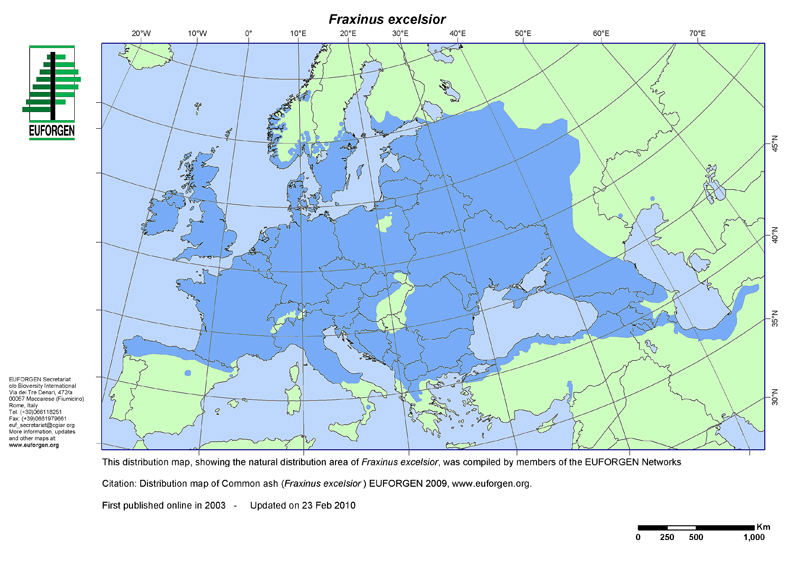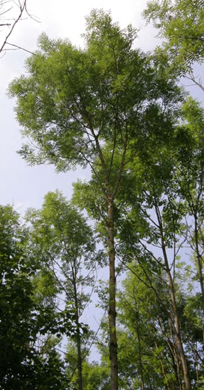-
Second most frequent broadleaved tree species in managed forests of Austria
- Wide site amplitude and enormous adaptation potential
- Among the most valuable broadleaved tree species in Europe
Common ash (Fraxinus excelsior) is a widespread native European tree species, whose distribution covers most of Europe from Scotland and Norway in the North, to the Iberian Peninsula (Galicia, Spain) and Italy in the South, and from Ireland in the West to Iran in the East.
According to the Austrian Forest Inventory (survey 2007-2009) common ash is the second most common native broadleaved tree after European beech, regarding the number of stems in the Austrian harvested forest (3,1%). In terms of growing stock (2,1%) common ash ranks on the third after European beech and oak. However, in the coming years a significant decline in these proportions has to be expected due to ash dieback.
Common ash can be found as main or associated species from colline to submontane altitudes on deep, humid fresh and nutrient-rich sites alongside water bodies (e.g. stream-alder-ash forest, ash-hardwood floodplain sites, moist soil beech- and oak-hornbeam forests). Owing to the root system ash can also be found on dry and less vigorous sites (e.g. limestone soil, sycamore maple-ash forest).[6,7]
This broad physiological amplitude illustrates the enormous site tolerance and potential for adaptation of this species. In Austria, common ash is frequently found in the northern foothills of the Alps at an altitude of 300 to 900 m a.s.l.
The ring-porous, hard and heavy wood makes ash one of the most valuable European broadleaved tree species. Due to a particularly high tensile, as well as a good bending and impact strength, ash wood is ideally suited for tool handles, sports and gym equipment and for usage in wheelwright‘s and joiner’s works (axles, drawbars, furniture veneers).[8]
The application of site-specific hardwood species is an indispensable measure to increase the stability of the entire forest stand and to secure the economic basis of forest management. Common ash is one of the most important admixed species on deep, fertile soils and in timber production. A loss of this nutrient demanding species in deciduous forests would lead to a lasting change in the forest ecosystem, particularly in rare forest communities (alluvial, slope and ravine forest).
Some red listed species depend on ash, e.g. the example of the scarce fritillary (Euphydryas maturna) detected in the „FFH- and LIFE-project“ areas Nationalpark Kalkalpen and Untersberg foreland. Its natural occurrence in sparse and humid forests is related to the presence of common ash since ash leaves are the sole source of nourishment for larvae.
Different habitats where common ash is present are already classified as (highly) endangered or particularly worthy of protection due to their tree species composition and other reasons (FFH directive, red lists for Austria). These facts further underline the importance of this conservation initiative.
The disappearance of common ash as admixed species reduces the wildlife ecologically important source of nutrition and limits the possibilities to influence the vulnerability by game of forest sites, drawing browsing and bark stripping away from ash to other tree species.
[6] Mayer, H. (1992). Waldbau auf soziologisch-ökologischer Grundlage. 4., überarbeitete Auflage. Gustav Fischer Verlag, Stuttgart, Deutschland.
[7] Roloff, A., Pietzarka, U. (2010). Fraxinus excelsior Linne, 1753. In: Roloff, A., Weisgerber, H., Lang, U., Stimm, B. (Hrsg.), Bäume Mitteleuropas. Von Aspe bis Zirbel-Kiefer. Mit den Portraits aller Bäume des Jahres von 1989 bis 2010. Wiley-VCH Verlag, Weinheim, Deutschland, S. 159–173.
[8] Schütt, P., Weisgerber, H., Lang, U. M., Roloff, A., Stimm, B. (2006) Enzyklopädie der Holzgewächse – Handbuch und Atlas der Dendrologie. ecomed Medizin, Verlagsgruppe Hüthig Jehle Rehm GmbH, Landsberg am Lech.
Fotos: Kirisits, EUFORGEN





